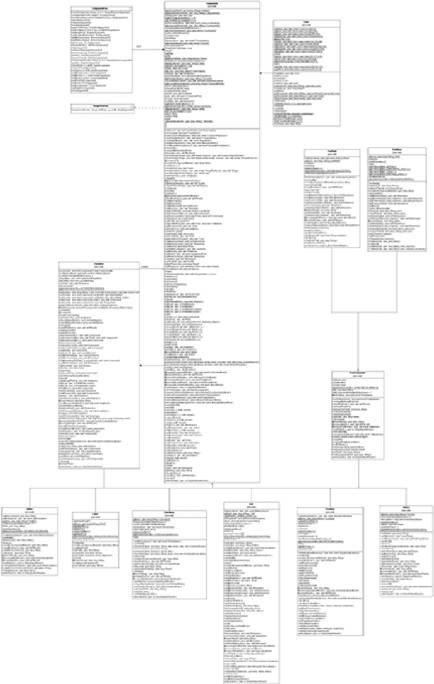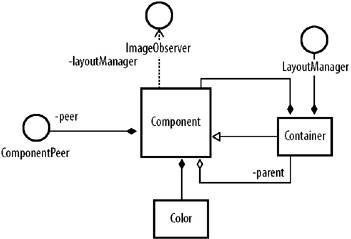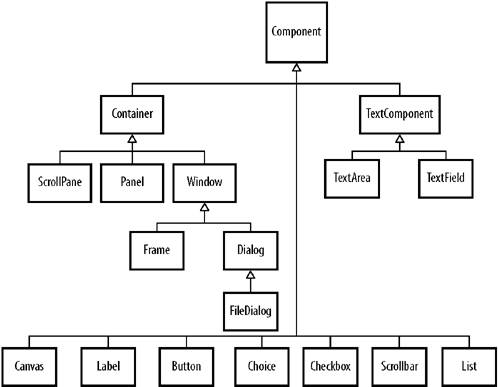Section 12.1. Wallpaper Diagrams
12.1. Wallpaper DiagramsThe classic novice class diagram displays all classes, attributes, operations, relationships, and dependencies for a system. As the number of classes grows, the diagram becomes huge and unmanageable. Imprudent reverse engineering drags in clutter. Figure 12-1 diagrams just a very small part of the Java Abstract Windowing Toolkit (AWT). You will not be able to read the diagram because it normally prints as an unwieldy nine pages. You're paying for the paper, so the diagram is shown here in a greatly condensed form. Effective writers convey ideas through language constructs: sentences and paragraphs organize text, details reinforce ideas, and true but irrelevant facts are omitted. Modelers desiring to convey an ideabe it a structural overview, a pattern implementation, a detailed subsystem, or the detailed context of one classmust also use economy and focus. Figure 12-1 has neither economy nor focus. The diagram throws a mass of insignificant detail at readers, leaving the burden of understanding on them. It is a false economy to think that one diagram can present all the information of a multidimensional model. Figure 12-1. An overloaded and ineffective class diagram 12.1.1. Modeling Versus DiagrammingBefore making Figure 12-1 more effective, let's distinguish modeling from diagramming. The act of modeling furthers your understanding of the system under study. You use diagrams to elaborate the model. You confirm the model integrity with new views. You organize your understanding. You extend your knowledge. You challenge your understanding. By seeing the known, you can infer, dictate, or investigate the yet to be known. Figure 12-1 might be seen during modeling, but only as an intermediate step; such diagrams don't demonstrate UML's true power to communicate. Diagramming, on the other hand, expresses understanding for the benefit of others. You may be a domain expert by background, or you may have recently synthesized expertise from modeling with domain experts. You have worked hard to understand, and to put your understanding into a model, perhaps over weeks or months; now you must make that understanding immediately accessible to your readers. Your model should be concise so that they understand. If there is to be contention, let it be about real ideas, not ambiguity. Diagramming reveals to others what you discover through modeling. It doesn't matter whether you formally create a model in a modeling tool, whether the model is implicitly in your head, or whether the model resides in another form: each diagram drawn from that model should express one or a very limited number of related concepts. You choose the idea to express, and you express it from the elements in the model. Presenting your ideas in UML requires multiple diagrams, just as writing a section in this chapter requires multiple paragraphs. Implicitly, you may think that discussions of layout and effective diagrams relate only to human-drawn diagrams. Automated utilities create one-way transformations to UML of complex text or XML-based configuration files or even nontext systems. This visual UML presents an alternative and complementary view to the difficult-to-understand source text, especially when used as overviews and sanity checks. Most such utilities automatically lay out the resulting diagrams without allowing the user to arrange the diagrams. (Manual arrangement would impose undue work on the user.) The need for clarity and focus applies equally to UML produced by tools because the reader is still the same. Though UML provides an excellent vehicle for both modeling and diagramming, the resultant diagrams aren't necessarily the same. Modeling tolerates larger diagrams with a muddled focus. A large diagram makes a better playground because the cost of refactoring many small diagrams outweighs the benefits of the clarity those diagrams provide, at least in the early stages of design. Once you understand the model and are comfortable with it, you can fission the resultant model more easily into packages and concise diagrams. Ease during this phase validates the model's completeness; pain in diagramming indicates incompleteness in modeling. Details forgotten against the vastness of the model stand out when the focus narrows to a very small context. Your documentation, UML and otherwise, must answer when you are absent. When you're publishing a guide to a toolkit, framework, or system, your audience will fail to exploit your offering without clear and focused diagrams. At the same time, once the model is clearly understood and concisely presented, discard the playground diagrams to avoid confusion. As with any other endeavor, shortcuts can be appropriate. If only you or an application generator access a model, you don't need to publish it for others. If the model is implicitly valid or you have better validation mechanisms, such as model checkers, you need not bother creating concise diagrams. A code generator, for example, doesn't care about understandable diagrams. No one diagram is definitive in all aspects. To be effective, a diagram must have unity of purpose. As a 2D view of the model, a diagram necessarily leaves out details in order to emphasize important features. The more economic the details, the more salient the features appear in relief. Several diagrams, each with a different purpose, provide a clearer understanding than one diagram that has all the details. When diagramming, consider the purpose. The following sections detail several errors that compromise the effectiveness of UML. 12.1.2. Structure and Interrelationships Among ClassesFigure 12-1 shows a class diagram cluttered by details. It gives no insight. Figure 12-2 shows the same classes without attributes and operations. More than half the diagram is an understandable inheritance tree. Rid now of clutter, what's left becomes readable. The converging lines draw the eye to Component at the center. You can clearly see the relationships between the abstract classes and various interfaces. The subclasses clearly add individual behavior without adding any structure. The diagram works. Once you understand the structure, you can find the details of operations and attributes elsewhere, in such places as source comment extraction tools such as Javadoc (supplied with the standard Java SDK from Sun) or CppDoc (check for it athttp://www.cppdoc.com/). Figure 12-2. The structure of commonly used components within the Java AWT Figure 12-2 illustrates that good diagramming doesn't need to show everything. Effective diagramming communicates one aspect of a system well. The less cluttered a diagram, the better. We chose to communicate the class structure of the Java AWT system. To that end, the diagram focuses on classes and their relationships, and leaves off details, such as attributes, which have no bearing on the knowledge we are trying to share. 12.1.3. Separate Inheritance and Class InterrelationshipsOur subset of the AWT doesn't contain enough complexity to require more simplification. Figure 12-2 mixes the abstract class relationships and the concrete classes using them. For even more clarity, together Figures 12-3 and 12-4 illustrate the same model as do Figures 12-1 and 12-2, but they separate the two concerns of abstraction and inheritance. Figure 12-3 focuses on the abstraction common to all the Components. With just two interesting classes and four supporting classes, Figure 12-3 is simple enough to memorize. That learned, the inheritance hierarchy of concrete classes in Figure 12-4 becomes easy to classify and to manipulate. Figure 12-3. Structure of Components and Containers in the AWT Figure 12-4. Inheritance tree of Component in the AWT |
EAN: 2147483647
Pages: 132